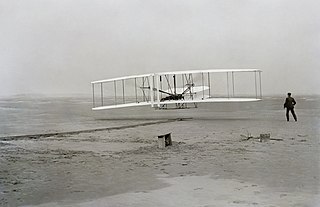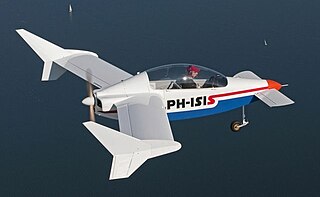
The Rutan VariEze is a composite, canard aircraft designed by Burt Rutan. It is a high-performance homebuilt aircraft, hundreds of which have been constructed. The design later evolved into the Long-EZ and other, larger cabin canard aircraft. The VariEze is notable for popularizing the canard configuration and moldless glass cloth composite construction for homebuilt aircraft.

In aeronautical and naval engineering, pusher configuration is the term used to describe a drivetrain of air- or watercraft with its propulsion device(s) after its engine(s). This is in contrast to the more conventional tractor configuration, which places them in front.

The Rutan Quickie is a lightweight single-seat taildragger aircraft of composite construction, configured with tandem wings.

The Scaled Composites ARES is a demonstrator aircraft built by Scaled Composites. ARES is an acronym for Agile Responsive Effective Support.

The Velocity XL is an American amateur-built aircraft, produced by Velocity, Inc. It is an enlarged version of their Velocity SE canard pusher design.

The PZL-105 Flaming (flamingo) is a Polish short-takeoff-and-landing (STOL) utility aircraft designed by PZL "Warszawa-Okęcie". It remained a prototype.

The Custer CCW-5 was a twin-engined, 5-seat aircraft of pusher configuration, which used a channel wing claimed to enable low speed flight and short take-offs. Two CCW-5s flew, eleven years apart, but the type never entered production.

The Douglas Cloudster II was an American prototype five-seat light aircraft of the late 1940s. It was of unusual layout, with two buried piston engines driving a single pusher propeller. Only a single example was built, which flew only twice, as it proved too expensive to be commercially viable.

The Falconar Golden Hawk is a Canadian tandem seat, pusher configuration, tricycle gear, canard-equipped ultralight aircraft that is offered in kit form by Falconar Avia of Edmonton, Alberta.

The Aeronix Airelle is a tandem wing ultralight with twin engines in push-pull configuration, that was designed and built in France at the start of the millennium. It was intended to be homebuilt from kits, and a few prototypes were constructed, but development ended when the company went into receivership in 2006.

The Junqua Ibis RJ03 is a wooden tandem seat pusher canard light aircraft, designed in France in the early 1990s for building at home. Eleven have flown and others remain under construction.

The LO 120 S is a German parasol-wing, pusher configuration, open-cockpit, two-seats in tandem motor glider that was designed and produced by LO-Fluggerätebau. When it was available it was supplied as a kit for amateur construction and meets European microlight rules.
The Latécoère 225 was an unusual single seat canard microlight amphibian, with a swept wing, and of pusher configuration. It first flew in 1984 but was not put into production.
The Aristocraft II was a six-place homebuilt aircraft designed by Terrence O'Neill.

The Microleve Corsario is a Brazilian amphibious ultralight flying boat that was designed and produced by Microleve of Rio de Janeiro. The aircraft was supplied as a kit for amateur construction.
The Briffaud GB-10 Pou-Push was a Mignet style tandem wing single seat aircraft with a pusher configuration single engine. The sole example was built in France in the 1980s.
The Bagalini Bagalini is an Italian homebuilt ultralight aircraft that was designed by Marino Bagalini. The aircraft is supplied in the form of plans for amateur construction.
The Laron Wizard is an American homebuilt aircraft produced by Laron Aviation Tech of Borger, Texas. When it was available the aircraft was supplied as a kit for amateur construction.
The Mathews Mr Easy is an American homebuilt aircraft that was designed by Lyle Mathews and associates and produced by the Vintage Ultralight and Lightplane Association of Marietta, Georgia. It was the sixth and final design of Mathews. The aircraft is supplied in the form of plans for amateur construction.
The Rotorwing-Aero 3D-RV is an American autogyro that was designed by Monte Hoskins and produced by Rotorwing-Aero of Salt Lake City, Utah, introduced in 1989. Now out of production, when it was available the aircraft was supplied in the form of plans for amateur construction.














